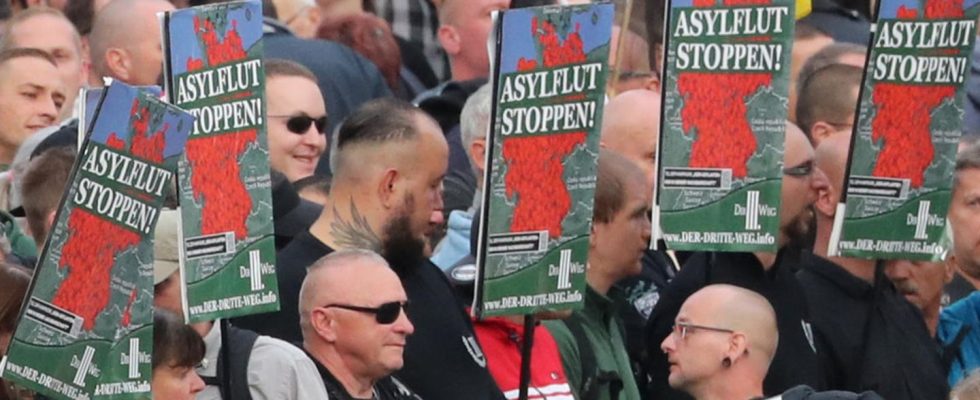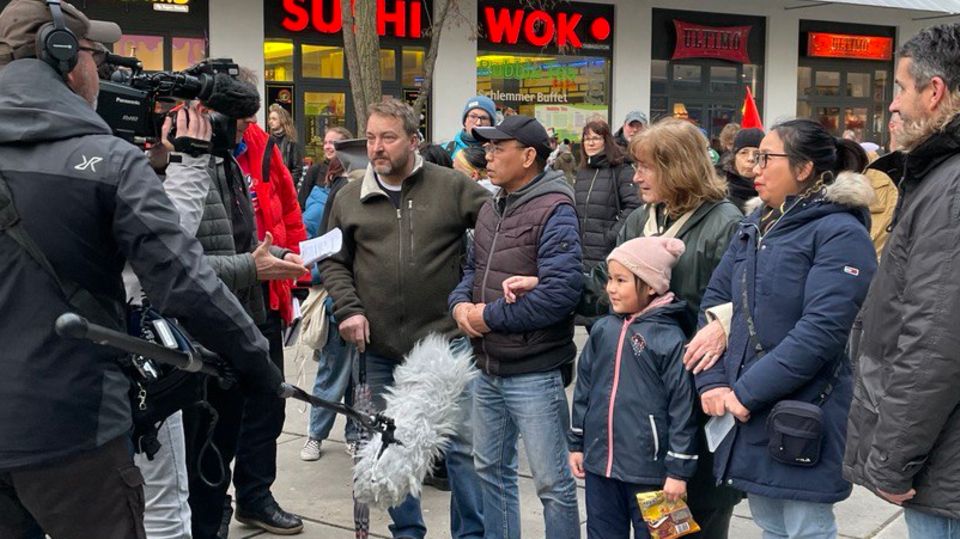“Closing ranks with the right-wing scene”
Five years after the riots: what about Chemnitz?
Right-wing demonstrators gathered in Chemnitz to demonstrate against the admission of asylum seekers
© Jan Woitas / DPA
The violent death of a 35-year-old was followed by massive protests and racist attacks in Chemnitz in 2018. Pictures of neo-Nazis and football hooligans drew international attention to the city, and there was talk of “hunts”. Where is Chemnitz today?
The plaque commemorating Daniel H., decorated with a peace sign, is easy to miss. In this place, large GDR reliefs with poems of praise for communism catch the eye. Here in the center of The 35-year-old died in Chemnitz at the end of August 2018, stabbed to death by a Syrian and an Iraqi. The violence was followed by a wave of demonstrations, in which previously inconspicuous citizens sided with neo-Nazis and football hooligans. Right-wing extremists joined forces to form the “Revolution Chemnitz” terrorist group, there were attacks on migrants and on the street some unabashedly boasted of the Hitler salute.
“What we saw here in 2018 was the right-wing scene closing ranks,” says Ulf Bohmann, a sociologist at Chemnitz University of Technology. That ranged from militant neo-Nazis to football hooligans to parties like Pro Chemnitz and the AfD. At the same time, through strong politicization, they have succeeded in mobilizing parts of the citizenry that cannot be classified as right-wing extremists.
Bohmann and colleagues took the pulse of a study of the city and its residents after the 2018 events. His conclusion: Similar events could have happened elsewhere. But in Chemnitz there were conditions that favored the whole thing. About a dense network of right-wing structures. And because the police and urban society had little to oppose, right-wing extremists could have presented themselves as the voice of the silent majority.
Foreign residents are still unsure
There were committed counter-protests such as a concert under the motto “#wirsindmehr”, in which bands such as Kraftklub, Die Toten Hosen and the rapper Marteria brought 65,000 people onto the streets. The reputation as a brown stronghold has stuck to Chemnitz like chewing gum to a shoe ever since. Even foreign skilled workers who have lived here for a long time report that fear is a frequent companion on the street. “Especially non-white people have been unsettled since then,” says André Loescher, who has been advising those affected by right-wing violence in the city for many years for the RAA Sachsen association. “It’s still in people’s minds.”
His club keeps its own statistics on right-wing violence. It shows that Chemnitz is not at the top in Saxony and is in the middle when it comes to acts of violence, he emphasizes. Last year, for example, 14 attacks were registered in Chemnitz, compared to 50 in Leipzig and 64 in Dresden. For example, people who are politically active against the right or who clearly have foreign roots are exposed to insults, are harassed or even attacked.
#wearemore
“Dear do-gooder than hat person” – that’s why so many came to Chemnitz
Sometimes it is enough to speak another language on the street. A cultural manager from abroad had to find out that in the spring. In March, he and his companions were attacked for speaking English. The 33-year-old was seriously injured, police said. An attack on the then head of the art collections, Frédéric Bußmann, also attracted national attention. Last year he confronted young people who were shouting Nazi slogans. They then surrounded and beat him.
Sociologist: Right-wing issues are interchangeable
Figures from the Office for the Protection of the Constitution recently showed a decrease in right-wing extremist crimes in Chemnitz. There were 116 in 2022 after 154 in the previous year. The number of right-wing extremists in Saxony is still at an all-time high. The experts also stated that right-wing extremist ideology is continuing to seep into other sections of the population and that the groups are always finding new topics with potential for outrage.
Sociologist Bohmann also observes that the right is striving to connect with broader sections of society. He refers to the many protests against corona protection measures or, more recently, against Russia policy and high energy prices. Such topics would be taken up by right-wing extremists without appearing too radical. “The specific topics are interchangeable – whether it’s Corona, peace, energy prices or gender,” says Bohmann. “They always manage to mobilize a similar clientele.”
Against this background, he and his colleagues are now talking about a “risk democracy”. The danger to society, then, is that the right will use democratic means and ideals to undermine and fight democracy itself. This was clearly shown in what happened as a result of the events in Chemnitz in 2018.

Chemnitz is Europe’s Capital of Culture 2025
But for the fourth largest city in East Germany after Berlin, Leipzig and Dresden, a new door has opened after the deep fall. In autumn 2020, she won the race for the title of European Capital of Culture 2025, leaving Hanover, Hildesheim, Magdeburg and Nuremberg behind. In the application book, the Chemnitz-based company clearly put its finger on the wound from 2018 and preceded the whole thing with two reports from the “New York Times” and the “Guardian” on the riots and the counter-protest at the time.
The idea: The Capital of Culture should not only serve urban development, but also be a project for social development. The aim is to activate the “silent middle” of the population – those people who do not take part in political debates or are politically active and thus indirectly promote social radicalization. It should be seen in two years’ time whether this will succeed, when – so it is hoped – many international guests will come here despite the battered image.


